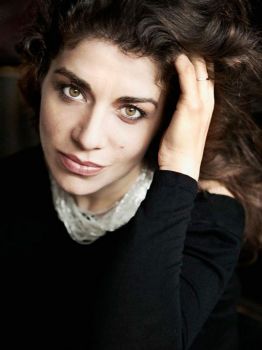|
Chamber
JASPER'S LUSH PERFORMANCES OF STILL, DVORAK AND FUNG QUARTETS
by Abby Wasserman
Sunday, November 10, 2024
Symphony
A SHOUT AND SONIC WARHORSES AT NOVEMBER'S SRS CONCERT
by Peter Lert
Saturday, November 9, 2024
Choral and Vocal
ECLECTIC WORKS IN CANTIAMO SONOMA'S SEASON OPENING CONCERT
by Pamela Hicks Gailey
Sunday, October 27, 2024
Symphony
FRANKENSTEIN THRILLS IN UNIQUE SO CO PHIL CONCERT IN JACKSON THEATER
by Peter Lert
Saturday, October 26, 2024
Choral and Vocal
BAROQUE EXTRAVAGANZA AT AMERICAN BACH MARIN CONCERT
by Abby Wasserman
Friday, October 25, 2024
Recital
LARGE AUDIENCE HEARS AX IN WEILL PIANO RECITAL
by Terry McNeill
Thursday, October 24, 2024
Symphony
SRS' NEW SEASON OPENS WITH BEETHOVEN AND COPLAND IN WEILL
by Terry McNeill
Saturday, October 19, 2024
Chamber
TWO CHAMBER MUSIC WORKS AT MARIN'S MT. TAM CHURCH
by Abby Wasserman
Sunday, October 13, 2024
CALLISTO'S ELEGANCE IN UPBEAT 222 GALLERY CONCERT
by Terry McNeill
Friday, October 11, 2024
Chamber
FINAL ALEXANDER SQ CONCERT AT MUSIC AT OAKMONT
by Terry McNeill
Thursday, October 10, 2024
|
 |
 Pianist Inna Faliks |
FAMILIAR WORKS AT VSO SEASON OPENER IN HOGAN
by Elizabeth Warnimont
Sunday, September 20, 2015
Guest conductor Thomas Heuser led a reconstituted Vallejo Symphony in its first concert of the new season Sept. 20 in Vallejo’s Hogan Auditorium. Mr. Heuser is the first of three candidates for the position of symphony artistic director, and each will conduct one concert.
There were familiar faces on the stage though most of the musicians are new to the VSO since last season, as many long-time members left the Orchestra after long-time artistic director David Ramadanoff departed last year.
Mr. Heuser chose some blockbuster works for his trial by fire, which, as he quipped on the stage Sunday, was an appropriate phrase given the near-100-degree temperatures outside. He sparked that fire conducting a brisk, pre-program Star Spangled Banner, for which virtually everyone in the audience stood, either with a hand over the heart or in formal salute. It was a refreshing surprise and a unifying icebreaker, for the orchestra as well as the audience. After the rousing rendition of the National Anthem, the orchestra proceeded with the first of three classical favorites, Smetana’s The Moldau. The Moldau, or “Vltava,” named after a majestic Prague river, is part of a series of six symphonic poems the composer completed late in his career, collectively titled “Ma Vlast,” or “My Homeland.”
“Each work takes its inspiration from a different aspect of Bohemian/Czech culture, landscape or history,” said the VSO‘s Mary Eichbauer, and “Vltava expresses the renewed strength and unified spirit of Bohemia.” In his introduction to the audience Sunday, Mr. Heuser described the piece as a contrast between the rugged and serene aspects of the river as it courses along toward its end, ultimately emptying into the Elbe River. “Rachmaninoff also had intense sadness and joy in his life,” he added, suggesting that the Smetana piece is also reflective of the life of its composer. The work is bold and elegant, containing obvious suggestions of flowing water (a steady beat emanating from the cellos and basses) as the violins play a sprightly melody accentuated by clear winds. The music is powerful in a gentle, aesthetically pleasing way. There was great majesty and confidence in the performance, but it is a happy confidence, a celebration of life and progress, devoid of fury.
The audience showed its admiration for the performance with a standing ovation. Rachmaninoff’s C Minor Concerto, Op. 18, followed with Ukrainian-born pianist Inna Faliks as the soloist. Ms. Falik's mastery is solid, and her performance with the symphony was strong and polished. Her precision and power was impressive, though piano and orchestra could have meshed more smoothly. In fact, while for the most part the orchestra sounded cohesive, the instrumental sections were not consistently in sync. The final movement was played energetically, and again audience applause was loud and long.
The program concluded with Dvorak's “New World” Ninth Symphony, Op. 95. The smoothness of the phrasing in the strings provided a foundation for the familiar themes and was reminiscent of the Smetana work. This E Minor work from 1893 contains fewer contrasts than the expressive Moldau and flows more steadily forward without marked passages of serenity or tumult. The music had quite a lulling effect in the warm Hogan, especially in the Largo where the instruments sounded most graceful and closely attuned to each other. As the piece gained momentum in the final Allegro the orchestra gained sonority and power, becoming more unified at the end.
It was a successful audition for the conductor. The fact of repeated standing ovations spoke volumes for the quality of the performance, but in addition there was a sense in the auditorium that many would be returning for the next two concerts and their candidate conductors, Christian Baldini (Nov. 8) and Marc Taddei (Jan. 31).
|

